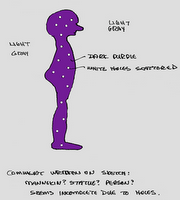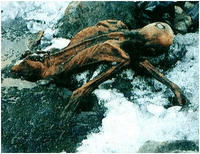
REMOTE VIEWING HINTS By James Burnett, Ph. D., P.E.
*note: [ I have been given permission to release this from a contact of mine James Burnett - Daz Smith]
Purpose:
Provided here is practical information on doing the remote viewing process. It will help beginners wanting to improve their performance.
For more information on remote viewing, I suggest the books listed at the end of this article.
Teachers:
My teachers were Dr. Keith Harary and Dr. Russell Targ, formerly of the STARGATE Remote Viewing Program at Stanford Research Institute (SRI).
Proficiency:
I have practiced remote viewing for years, and experienced steady improvement in performance while doing a lot of double-blind viewings. Practicing allowed me to find a good personal viewing procedure and to learn to recognize an incoming signal. There are probably as many different procedures for remote-viewing as there are proficient viewers.
People find a viewing procedure that works best for them. I will give you mine. At this point my viewings, done with double-blind setups and independent judging, deliver a success of about 90%. About 1 in 10 of my viewings has very high detail.
RV Pictures:
I receive RV data in the form of pictures. What I get is a gradually formed picture, which starts out as a vague image on the "inner screen", which some people think of as the location of the "third eye".
Then, the picture gradually fills in with more detail and color. I interrupt during a viewing and sketch and write comments on what I have seen so far. Then, I go back to the viewing process -- which does not seem adversly affected by the interruption.
It takes me patience to view successfully. Commonly, five minutes or more will pass before any image starts to appear. Then, it might take another five minutes or more for the picture data to fully fill in. During the viewing, I commonly interrupt and add to the sketch as many as three times, plus once more after the end of the viewing. When the picture stops filling in more details, the viewing is effectively done.
About one in ten times, I will get a very high detail colored picture -- nearly a photograph. It might have to do with how well I kept my objective mind's thinking away from the viewing process.
The rest of my viewings (except the high detail viewings) appear as a "cartoon". (See Figure 1. below). I have always thought it weird that The Universe chooses to communicate in the form of these cartoons, but there you are. In viewings where I get cartoon responses, the cartoons are usually unclear on what they represent. They become obvious when examined against the double-blind targets by the judges.
In real target viewing with a cartoon response, one has partial data on the target. So, data is usually needed from more than one viewer to try to fill in more of the details.
Cartoon Data Example:
This article shows only one cartoon example, because this particular cartoon demonstrates fully the nature of these cartoons. Figure I is a cartoon picture I received in a double-blind practice exercise. My interpretation comments, at the bottom of the sketch, were added after the viewing ceased.
One cannot interpret the data during an on-going viewing, because the intervention of the objective mind kills the viewing connection immediately. This target first gradually filled in as the outline shape. Then, the purple field filled in. Then, the holes appeared. That was it.
Figure 2 is the practice target viewed, which turned out to be a picture of a dead body. So, it is possible to RV a picture of a dead body. I do not know if that means that one can RV a dead body, rather than the picture as I did.
FIGURE 1:


FIGURE 2:
ACTUAL DOUBLE-BLIND TARGET: "OTZI -- THE ICEMAN"
"Ötzi" was found by two hikers in 1991 in the Italian Alps. The body was at first thought to be a modern corpse. He was then determined to have died about 3300 B.C., and has been preserved by the ice since then.
Bias:
I note a bias in my viewings.
I see physical objects and fire from the target, but do not see the live people. In one viewing, I did see the dead body which was the target. A professional-psychic female associate saw the live people in the same viewing exercise. But, she did not see the fire, and not much of structure.
It seems viewers have different sensitivities when viewing the same target at the same time. This is another reason for using several viewers on a real target.
Recognizing a Good Signal:
Oddly, I found that a reliable indicator for me of a successful viewing going on is that my mind whispers to me: "You have got it wrong; you are going to look like a fool if you take this as a good viewing." Those were the times when I got a really good viewing. It seems my mind does not like the RV process, and I have to struggle with that situation.
Avoiding Mind Interference:
An important part of the viewing procedure is to keep my thinking mind from entering and trying to "help". It must remain only in the role of an observer and recorder. Once my thinking mind enters the process, the viewing immediately ceases. It was a struggle until I learned to make an arrangement with my mind at the start of the viewing process.
My personal viewing initiation process:
When I do a viewing I always begin by saying to my inner mind these statements:
"It is okay that this viewing does not work, as long as I do the process correctly." "I draw whatever comes in; I do not try to understand it." "Thinking Mind please act only as an observer, and please do not help otherwise. Thank you." "Please show me the information in present time." (Or, future or past time.) "Please show me the Target now."
This viewing initiation procedure works for me, and resulted in a big improvement in my viewing results.
Targeting:
In practice situations, the double-blind targets are randomly selected by some device just before being read. No human knows what the target is until after the viewing is complete. In such practicing, SRI found that the viewer only has to say: "Show me the Target now". The viewer does not have to otherwise identify the target in any other way, except to specify time. Somehow, the Universe knows the correct target.
There are sometimes targeting errors during multiple viewings -- such as when the target actually viewed is the one following the one blind-selected to be next viewed. This can occur even though the target-after has not yet been selected. So, the Universe seems to have a view of the future regarding targeting. SRI found out that viewing can easily be out of present time, so the viewer must give an instruction regarding in what time do they want to view.
The time can be highly specific in looking into the past. There are other ways to target, such as coordinates, which are covered in the suggested books. Dr. Harary said that targeting is the greatest mystery of remote viewing.
Putting It Down:
In viewing, if one might be seeing something but is unsure, then, that is the time to start putting it down. That is how it is done. In my case, the picture gradually develops. If a viewer starts judging whether or not they are seeing a real target, then the thinking mind gets into it and kills the viewing.
Practice:
Practice, with a lot of double-blind readings and independent judging, does the most to improve one's proficiency.
Communication:
Dr. Burnett can be reached at whitecrow888@yahoo.com
BACKGROUND Dr. James Burnett, P.E. is a retired physicist who studies psychic phenomena as a scientist. His academic degrees are:
- B.S. in Aeronautics
- M.S. in Nuclear Engineering and Mathematics
- Ph. D. in Physics
- P.E. as a Licensed Professional Nuclear Engineer
- His studies were at the University of Michigan
- Dr. Burnett performed research and development for the Advanced Research Projects Agency (ARPA); the Atomic Energy Commission (AEC); National Aeronautics and Space Administration (NASA); the U.S. Air Force, the U.S. Navy and the U.S. Army, and other agencies.
No comments:
Post a Comment
Note: Only a member of this blog may post a comment.